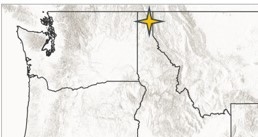Kootenai valley bottom as viewed from the project site | Photo: Mitch Doherty, Vital Ground Foundation
North Idaho Conservation Acquisition Maintains Open Corridor for Grizzlies and Other Wildlife
BOUNDARY COUNTY, Idaho (29 December 2023 | Vital Ground Foundation) – Grizzly bear recovery in the Lower 48 states often focuses on the bear populations in and around Glacier and Yellowstone national parks, but in Montana’s northwestern corner and the northernmost reaches of the Idaho Panhandle, the Kootenai River Valley plays a major role in the conservation prospects of the two smallest groups of grizzlies persisting south of Canada.
 Those bears and countless other wildlife species will benefit from Vital Ground’s final habitat protection project of 2023, as this week the organization completed the purchase of 98 acres in far northern Idaho, just south of the Canadian border.
Those bears and countless other wildlife species will benefit from Vital Ground’s final habitat protection project of 2023, as this week the organization completed the purchase of 98 acres in far northern Idaho, just south of the Canadian border.
Splitting the Purcell, Cabinet and Selkirk ranges, the Kootenai River flows west through the northwestern corner of Montana then turns north in the Idaho Panhandle, carving a wide valley on its way into Canada. For over 20 years, Vital Ground has protected key pieces of private land in this valley, helping grizzlies, moose, elk, wolves and much more move between the Selkirk Mountains to the west and the Purcell Mountains to the east.
 With major support from the Yellowstone to Yukon Conservation Initiative (Y2Y), this week’s acquisition in the Smith Creek drainage lies within a mile of several other Vital Ground project sites as well as state and national forestlands and the Boundary-Smith Creek Wildlife Management Area, further solidifying an open movement corridor across the valley for wildlife.
With major support from the Yellowstone to Yukon Conservation Initiative (Y2Y), this week’s acquisition in the Smith Creek drainage lies within a mile of several other Vital Ground project sites as well as state and national forestlands and the Boundary-Smith Creek Wildlife Management Area, further solidifying an open movement corridor across the valley for wildlife.
“Working with Vital Ground and willing landowners to conserve lands like this 98-acre property is both strategic and critical,” says Eric Greenwell, Y2Y’s Senior Connectivity Specialist. “This particular property’s value to wildlife is two-fold: Not only does it sit between the Purcells, Cabinets and Selkirks in the larger landscape, it connects National Forest to incredible habitat in the Boundary-Smith Creek Wildlife Management Area and along the Kootenai River, where Y2Y has made significant restoration and climate adaptation investments through our Bees to Bears Project, compounding benefits to wildlife and building on the remarkable work of great partners.”
The Slow Path to Grizzly Recovery
Biologists estimate a population of 50-60 grizzlies endures in the southern portion of the Selkirk Ecosystem surrounding the borders between Idaho, northeastern Washington and British Columbia. On the other side of the Kootenai Valley, the Purcell Mountains descend from Canada to form part of the Cabinet-Yaak Ecosystem, home to another group of 50-60 grizzly bears.
With only a handful of documented cases of gene flow between these populations, maintaining habitat connectivity is crucial to avoiding a future of genetic isolation and eventual extinction for these grizzlies. And with development pressure high across the region, protecting private lands in key corridors is an essential prong in allowing the populations to slowly grow, connect and diversify.
“There’s constant pressure to divide and develop land,” says Greg Johnson, a retired biologist for Idaho Fish and Game who worked on grizzly recovery in northern Idaho for multiple decades. “Where Vital Ground has their most important role is to take on the smaller projects in those really key critical areas. The lower elevations are bottlenecks for key species like grizzly bear. The number one threat is the permanent loss of those habitats.”
Wide-Reaching Benefits

Figure : Cedar grove on the project site.
Known as “100-Acre Wood,” Vital Ground’s newly-acquired property features mixed conifer forest, with a seasonal creek running through the acreage. As part of Vital Ground’s One Landscape conservation strategy, several bear biologists and managers noted the property and surrounding area for its connectivity value and high-quality seasonal habitat for grizzlies.
Previously owned by the Owens Foundation for Wildlife, the property will be protected from subdivision in perpetuity and stewarded to maximize its habitat value for the region’s broad diversity of wildlife, from bears to migratory birds to rare sensitive species including Canada lynx and wolverine.
Furthering Vital Ground’s larger One Landscape Initiative, the project combines with other habitat protection efforts in northern Idaho and the Montana portion of the Kootenai Valley to create a more connected landscape for the Selkirk and Cabinet-Yaak’s recovering grizzlies. In the face of development pressures, it also maintains the rural and scenic nature of one of the wildest portions of the Mountain West that doesn’t include a national park or large protected wilderness area.
“North Idaho, just like a lot of the West, is facing a surge in population growth and subsequent development pressure,” says Mitch Doherty, conservation director for Vital Ground. “This particular area near the Canadian border is remote, rugged and some of the most spectacular country in the Northern Rockies. This project will retain that ruggedness and beauty that the longtime residents cherish and wildlife needs.”
![]() Additional support for the 100-Acre Wood project came from Atira Conservation and the McDanel Land Foundation.
Additional support for the 100-Acre Wood project came from Atira Conservation and the McDanel Land Foundation.

